 Back in February, we received a Borealis Telluride demo to ride and review. We took the bike down into the shop and built it up just in time for our product tester (Ronsta) to be headed out of town on vacation. Since the bike was the size I ride, I decided upon a short term adoption or fostering of the Telluride (just until the return of the Ronsta). The bike came shipped in two cartons. The wheelset in one box and the bike with both a Manitou Mastodon Suspension Fork and a rigid carbon fork in the other. The bike was packaged so well that I had to take a picture of the way that they zip tied the preassembled frame/bars/etc to a corrugated cardboard insert that fits perfectly into the outer bike box. Smashing job gents!
Back in February, we received a Borealis Telluride demo to ride and review. We took the bike down into the shop and built it up just in time for our product tester (Ronsta) to be headed out of town on vacation. Since the bike was the size I ride, I decided upon a short term adoption or fostering of the Telluride (just until the return of the Ronsta). The bike came shipped in two cartons. The wheelset in one box and the bike with both a Manitou Mastodon Suspension Fork and a rigid carbon fork in the other. The bike was packaged so well that I had to take a picture of the way that they zip tied the preassembled frame/bars/etc to a corrugated cardboard insert that fits perfectly into the outer bike box. Smashing job gents!
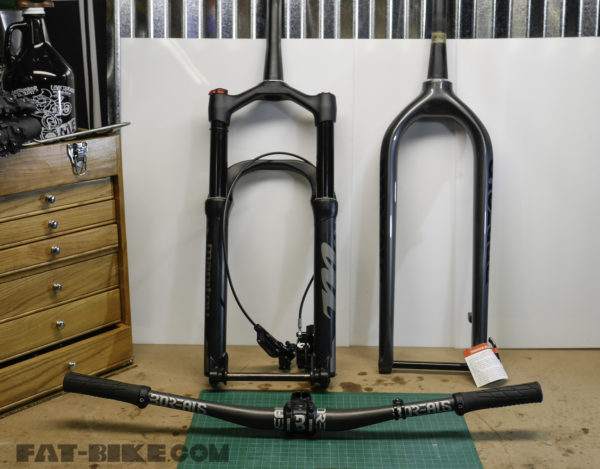
The bike as tested sells for an MSRP of $3,200 which includes a Manitou Mastodon EXT Pro and a Borealis Rigid Carbon Fork
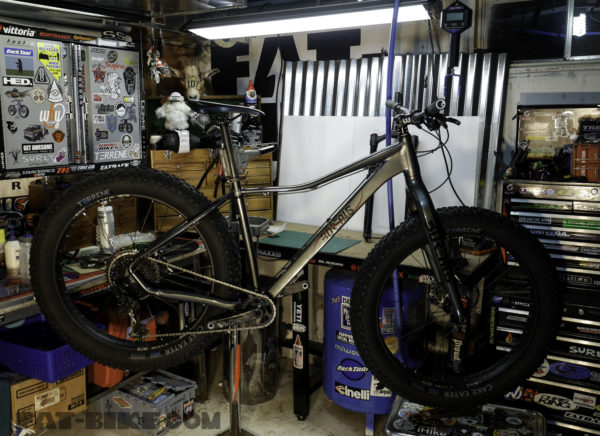
Our Size Large Frame weighed in at 31 Lbs 7 oz. (including a pair of RaceFace Chester platform pedals)
The Telluride features a narrow Q-Factor (83 mm bottom bracket) and comes with these new-fangled 27.5 wheels that we’ve been blathering on about for the last couple of years. One notable difference with the wheels that come on the T-Ride is their 65mm width. Our demo came shod in the largest B-Fat tires – the Terrene Cake Munchers (27.5 x 4.5). The combination offered a very workable winter footprint even for my ample tookis. One of the most unique things about the Telluride that I had overlooked until I built our demo was the cast aluminum rear dropouts. Previous to this, I’d never seen a fat-bike with dropouts like these.
SPEC’S
Frame – Borealis Telluride 6066 Lightweight Alloy (Metallic Silver w/3 Decal Options)
Fork – Borealis Carbon Rigid Fork & Mastodon EXT Pro 120mm
Headset – Borealis
Hubs – Borealis: Front 15×150 Rear 12×177
Rims – HED 80mm Alloy 27.5 x 80mm / MuleFut 27.5 x 65mm
Spokes – Wheelsmith Black
Nipples – Wheelsmith Silver Brass
Tires – Terrene Cake Eater 4.0 / Terrene Cake Eater 4.5
Bar – Borealis Carbon Bar 35mm
Stem – Borealis 50mm/70mm for XL
Post – Borealis Carbon 31.6mm
Saddle – Borealis
Grips – Ergon GA30 or GP1 L (Paddle)
 Crankset – RaceFace Next R (Carbon) 30T Chain Ring
Crankset – RaceFace Next R (Carbon) 30T Chain Ring
Bottom – Bracket Race Face BSA30 x 83mm
Rear Derailleur – SRAM Eagle GX 12 Speed
Chain – KMC 12 Speed
Cassette – SRAM Eagle GX-1275 10-50
Shifters – SRAM Eagle GX 12 Trigger
Brakes – SRAM Guide RS w/180mm rotors
Weight – 31 lbs – 7 oz
Initial Ride Impressions
The first time that I took the Telluride out, I noticed that the stack height was too high for my liking. I slammed the stem all the way down and that took care of the issue. I enjoyed my short time with the Telluride. It’s a solid bike and I have no real complaints. There is a subtle difference between this B-Fat platform and the fat-bike that I normally ride. And let me emphasize again that the difference is very small and that the difference can sometimes lead to a slight advantage and sometimes (dependant on conditions) become a slight detriment. B-Fat is a taller wheel format and sometimes that taller wheel rolls over and through snow better. The big wheels maintain their momentum and offer excellent traction and propulsion. When conditions become dicey and the path is rutted or the snow has variable densities, I feel like the added height makes it more difficult for me to maintain my balance point. That could be my lack of skill or a dozen other variables, but I’ve spent a lot of time switching between the two wheel set-ups and especially for rut riding, I feel the slight advantage goes to 26″. This is specific to B-Fat at the 4.5 widths only. The largest B-Fat tires create a wheel with a 31″ height. The smaller 27.5 x 4.0 tires do not change the overall wheel diameter very much from a standard 26″ fat bike setup.
When I was up at the (real) Sweaty Yeti at Levis I offered to let a bunch of people experience ‘the miracle’ of 27.5″ B-Fat and several folks took me up on it. I wonder if they realized that I was being sarcastic with my miraculous gnomenclature? Everyone that test rode the Telluride came back with good things to say about it and several people told me that the T-Ride was kick-ass! The commentary in the paragraph above is really more the result of my continued research of riding the new wheel diameter and shouldn’t be considered as a ding on the Telluride in any way.
Ronsta is back from vacation and he’s putting the T-Ride to good use all over the state. He’s already landed on the podium at a Hugh Jass race up in Neenah and he’ll have a much more definitive review of this new offering from Borealis. This is a preview of Ron’s Review. Stay tuned for his full review somewhere down the trail amigos!
For more information visit – https://www.fatbike.com/store/TELLURIDE-EAGLE-GX-p124040091

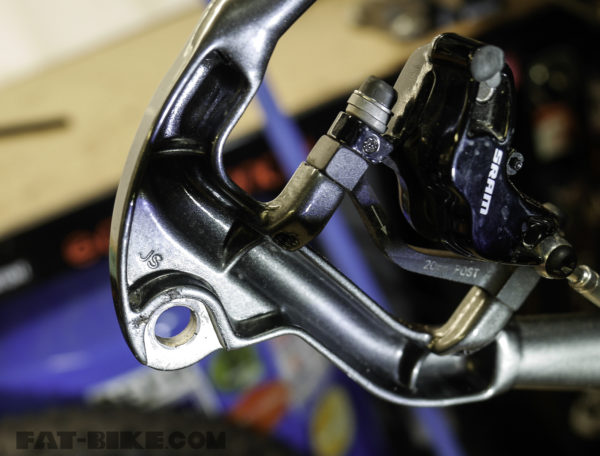
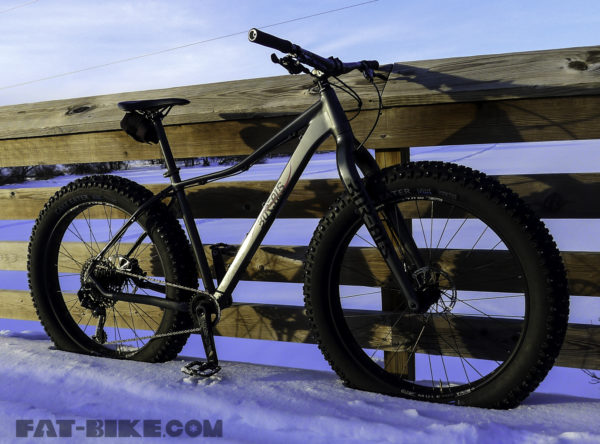
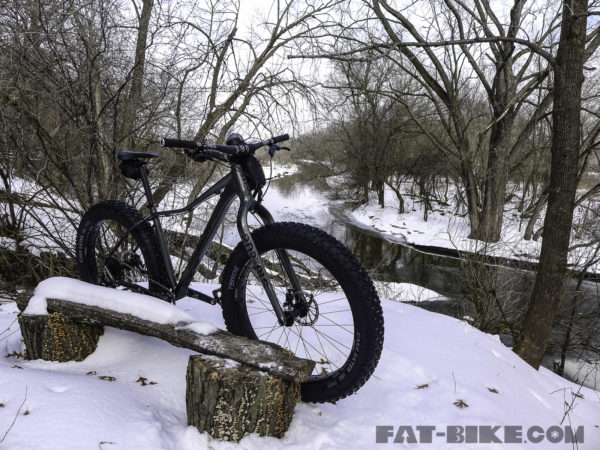
Shouldn’t a 27.5 wheel have tires with a slightly shorter sidewalls? If someone was worried about overall weight of their bike,why would you be ok with the additional weight of more rubber? I am not trying to be harsh. I am still not sure of the advantages of the new wheel size. Just wanted some clarification for future fat bike purchases.
Some B-Fat 3.7-4.0 have shorter sidewalls but the two 45 Nrth B-Fat offerings in 4.0 do not. The B-Fat 4.5’s (Gnarwhal and Cake Easter) have taller sidewalls.
Excited to hear what Ronsta thinks. I haven’t had experience with the B-Fat size as of yet, but I was at said Hugh Jass race where the conditions were rough with +/- 6″ of dry light snow on top of the groomed trail that didn’t pack down until my second lap (Ronsta was probably on his second beer @ the lodge by the time I finished:). What I noticed, while being lapped, was that those running B-Fat had the same issue as you described above –
“When conditions become dicey and the path is rutted or the snow has variable densities, I feel like the added height makes it more difficult for me to maintain my balance point.” –
where as those running 26″ were better able to “stay in the groove”. I wonder if it’s because of the longer rather than wider contact patch?
Eh, what do I know. Salud Tio Gomez!!
If that’s the case Erv, at 6’5” tall I definitely do no want to raise my centre of gravity any higher than it already is. I have enough trouble clearing low branches as is.
The Scott Big Jon has a very similar rear dropout. I was a bit unnerved by the look of it, but so far, it’s held up just fine and I’ve found no reports of any weird frame issues.